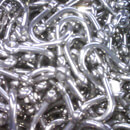Lifting Shackle Technical Information - CE marked, WLL
High Tensile 17/4 PH Stainless Steel Lifting Shackles - Technical Information & Certification
PH LIFTING SHACKLE TECHNICAL SHEET download here
Product Information
PH lifting shackles are made from PH 17/4, a martensitic precipitation/age hardening 17% chromium, 4% nickel stainless steel, offering high strength and hardness together with excellent corrosion resistance. PH lifting shackles are heat treated to between condition H1025 and condition H1075 to achieve the optimum balance of mechanical properties and resistance to corrosion: in this state PH 17/4 closely approaches stainless types 302 and 304 for most corrosion agents.
Because of the critical dependence of the strength/corrosion characteristics on the heat treatment process it is imperative that no attempt is made to anneal PH lifting shackles for whatever reason.
Lifting Shackle Marking
| For example | SWL 2t PH A55 ce | |
| WLL 2t | Working Load Limit (in tonnes) | |
| PH | manufacturer's/material indentification | |
| A55 | test batch reference number | |
| ce | mark certifying compliance with relevant standards |
Working Load Limit (WLL)
Working Load Limit (WLL) is the maximum working load designed by the manufacturer. This load represents a force that is much less than that required to make the lifting equipment fail or yield. The WLL is calculated by dividing MBL by a safety factor (SF).
Spreading of load
The load must not be concentrated over a small area e.g. by knife edges or small diameter steel ropes.
Operating temperature
If the intended environment of the PH lifting shackle involves elevated or depressed temperatures then please contact S3i for advice.
Inspection of lifting shackle
Before the lifting shackle is first put into use it should be examined for signs of damage. If it is known, or suspected, that the lfting shackle has been subjected to an excess load it must be carefully examined. Should the lifting shackle show any sign of cracking, splitting or deformation it must be destroyed.
In the event of damage to the lifting shackle it must be examined to determine its suitability for further use.
Further technical information
A typical analysis of PH 17/4:-
| Carbon | 0.07% max |
| Manganese | 1.00% max |
| Silicon | 1.00% max |
| Phosphorus | 0.04% max |
| Sulphur | 0.03% max |
| Chromium | 15.50 - 17.50% |
| Nickel | 3.00 - 5.00% |
| Columbium & Tantalum | 0.15 - 0.45% |
| Copper | 3.00 - 5.00% |
| Iron | up to 100% |
Mechanical properties - minima
| Ultimate tensile stength | 10,900kg/cm2 (H1025) to 10,190kg/cm2 (H1075) |
| Yield strength (0.2%) | 10,190kg/cm2 (H1025) to 8,790kg/cm2 (H1075) |
Mechanical properties - typical
| Ultimate tensile stength | 11,810kg/cm2 (H1025) to 11,530kg/cm2 (H1075) |
| Yield strength (0.2%) | 10,390kg/cm2 (H1025) to 10,410kg/cm2 (H1075) |
Page content by Nick Arrowsmith Google+


